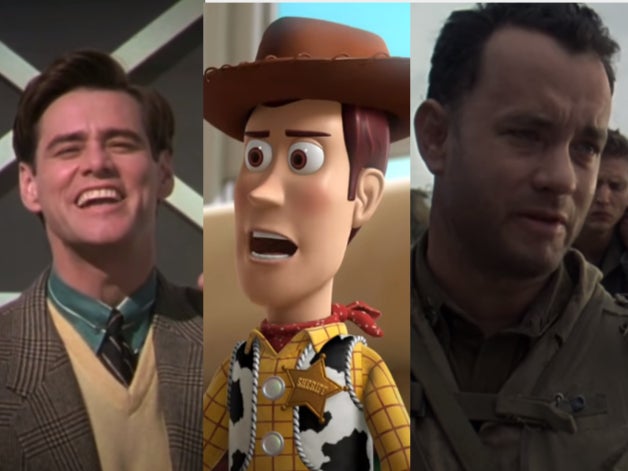
By now, we are all aware of the rampant sexism and lack of diversity within Hollywood films.
A website called Pudding has now been able to truly measure how bad the problem really is by compiling character screenplay dialogues of male and female characters in over 2,000 films (oh, and it’s bad).
And to no one’s surprise, white men appear to do most of the talking... which figures.
A breakdown of the 2,000 screenplays by gender clearly shows a swing when it comes to male characters, with the dialogue in 1,513 films being over 60% male - 301 in this figure had over 90%.
Meanwhile, just 164 films had dialogue that was 60-90% female - and just nine of them had over 90%.
There were 314 films that had gender parity (equal amount of male and female dialogue, give or take 10%).
Look at the gender breakdown of who speaks in popular films! pic.twitter.com/Jq5CEerex2
— John B. Holbein (@JohnHolbein1) October 12, 2021
So what else did this information reveal?
Disney films: Male characters dominate
Our favourite childhood films are dominated by male characters.
According to the compilation, 22 of 30 Disney films have a male majority of the screenplay dialogue.
The worst culprits for this were The Jungle Book, Monsters Inc, Up and Toy Story, who all had at least 92% male screenplay dialogue.
Male characters dominate the scripts of most popular Disney movies. pic.twitter.com/NaFBbWhX4H
— John B. Holbein (@JohnHolbein1) October 12, 2021
Along with nineteen other Disney films where the male dialogue was more prominent.
Even in films with female leads, such as Mulan, the dialogue remains male dominant - for example, Mushu, her protector dragon, has 50% more words of screenplay dialogue than Mulan herself, who the film is based on.
Despite Frozen having two female leads - Anna and Elsa - it’s the men who do most of the talking with the screenplay dialogue being 57% male and 43% female.
Meanwhile, there are just a handful of films where the screenplay dialogue is mainly female, Inside Out (64%), Alice in Wonderland (65%), Maleficent (68%), and Sleeping Beauty (69%).
Leading ladies are still in second place
While you might expect some of the most memorable leading ladies of popular film to have the majority of the lines - or at least half - this appears not to be the case.
In just 22% of the films analysed, actresses were leading with the most dialogue.
Second place appeared to be a common occurrence for women in 34% of the films.
However, women occupy at least 2 of the top 3 roles in a film in just 18% of the films - whereas for men this happens in 82% of films.
Opposing results for men and women in age
The data appears to show a clear pattern that differs for men and women when it comes to how age affects the amount of screenplay dialogue.
While dialogue opportunities dwindle with age for women as they get older (women aged 22-31 spoke the most words), this doesn’t appear to be the case for men whose dialogue increases with age (men aged 42-65 spoke the most words).
Women who do speak in popular films tend to be younger, while the men that speak tend to be older. pic.twitter.com/EutG8l17CJ
— John B. Holbein (@JohnHolbein1) October 12, 2021
Films with 100% male dialogue
Here are some examples of films that have 100% male dialogue in only High-Grossing Films: Ranked in the Top 2,500 by US Box Office.
- The Hunt for Red October
- Master and Commander: The Far Side of the World
- Platoon
- Saving Private Ryan
- Shawshank Redemption
- Stand by Me
- Lone Survivor
- There Will Be Blood
- Escape from Alcatraz
- Fury
- Crimson Tide
- Black Hawk Down
- The Grey
- Space Jam
- The Revenant
- The Adventures of TinTin
- Last Action Hero
- Schindler’s List
Films with 100% female dialogue
Here are some examples of films that have 100% female dialogue in only High-Grossing Films: Ranked in the Top 2,500 by US Box Office (there is literally just one).
- Now and Then
Since these findings have been published, they have been circulating on social media and people shared their thoughts after finding out this information.
While many weren’t surprised, some were still taken aback at the visual representation of the lack of diversity.
Not a surprise, but wow. https://t.co/uvHZLDmtNi
— Marie Garrrrghdiner 🎃 (@MarieGardiner) October 16, 2021
Thread. Jesus wept. https://t.co/gV5VYV4C08
— DarkMatterMascot (@racheledini1) October 16, 2021
I’m sure there is not one woman who is surprised by this. It’s the same in real life in work situations. https://t.co/oUsNtWi7lQ
— Not Today Satan aka Desantis (@NotToda52393553) October 13, 2021
When you know something to be true, but then you see it visualised.... (FFS) https://t.co/tqbPq0z2GH
— Jessica Moxham (@jessmoxham) October 13, 2021
The data can show what we mean by the word "systemic." https://t.co/3r9ZHWIq97
— Holly Chasan-Young (@hmaisonjames) October 13, 2021
Awesome graphic. Grim results. https://t.co/SgdQrAJmZP
— Sigmund Freund (@Freunds_Mullet) October 13, 2021
BRB gonna scream into the void. https://t.co/GpII6Fj0wx
— Angela Chaisson (@angelawya) October 13, 2021
While someone else shared their interest in finding out if this result would be the same in different movie industries around the world such as in Bollywood and Korean films.
This is extremely US/Hollywood-centric. I wonder if the data from various other movie industries would differ. Are the Korean movies' number similar? What about Bollywood? https://t.co/Yxbj5VA3u9
— Anne O'neam, famed musclemancer! 🤏🏿 (@AnneOneamous) October 14, 2021
To view the full visualisation, visit Pudding.







